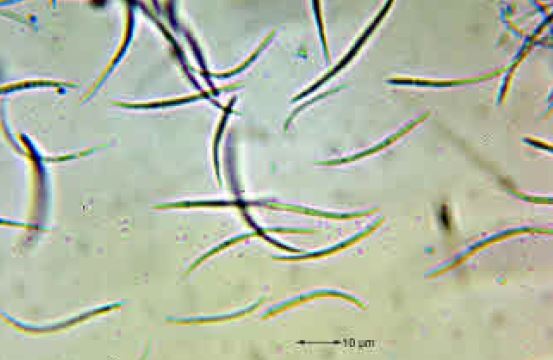Micarea peliocarpa (Anzi) Coppins & R. Sant.
in Coppins & James, Lichenologist, 11: 155, 1979. Basionym: Bilimbia peliocarpa Anzi - Atti Soc. Ital. Sc. Nat. Milano, 9: 250, 1866.
Synonyms: Bacidia albidolivens (Nyl.) Zahlbr.; Bacidia hemipolioides (Nyl.) Zahlbr.; Bacidia peliocarpa (Anzi) Lettau; Bacidia trisepta (Nägeli) Zahlbr.; Bacidia triseptatuloides (Harm.) Zahlbr.; Bacidia violacea (P. Crouan & H. Crouan ex Nyl.) Arnold; Bilimbia albicans Arnold; Bilimbia hemipolioides (Nyl.) A.L. Sm.; Bilimbia subviridescens var. trisepta (Nägeli) A.L. Sm.; Bilimbia trisepta (Nägeli) Hellb.; Lecidea albidolivens Nyl.; Lecidea fraterculans Nyl.; Lecidea hemipolioides Nyl.; Lecidea triseptatula Nyl.; Lecidea triseptatuloides Harm.; Lecidea violacea P. Crouan & H. Crouan ex Nyl. non A. Massal. nom. illegit.; Micarea trisepta (Nägeli) Wetmore; Micarea violacea (P. Crouan & H. Crouan ex Nyl.) Hedl.
Distribution: N - Frl, Ven (Brackel 2013), TAA (Hinteregger 1994, Nascimbene & al. 2007b, 2022, Nascimbene 2008b, Nimis & al. 2015), Lomb, VA (Piervittori & Isocrono 1999), Emil (Nimis & al. 1996, Tretiach & al. 2008, Fariselli & al. 2020), Lig (GE 145). C - Tosc (Benesperi & al. 2007), Umb (Ravera 2000, Ravera & al. 2006), Sar (Zedda 2002). S - Cal (Puntillo 1995, 1996), Si (Nimis & al. 1994).
Description: Thallus crustose, usually episubstratic, greenish white to blue-grey, of convex, to 0.2 mm wide areoles, rarely endosubstratic and poorly evident. Apothecia micareoid, rounded, sessile, not constricted at base, sometimes confluent and tuberculate, 0.15-0.7(-1) mm across, with a whitish to grey-black, flat to usually convex disc, and a thin, finally often excluded proper margin. Proper exciple thin but usually evident, colourless; epithecium scarcely differentiated from the hymenium; hymenium colourless in lower part, greenish to blue-green in upper part, the pigmented parts K-, N+ red, 40-55 µm high; paraphyses conglutinated, branched and anastomosing, 1-1.5 µm thick at mid-level, the apical cells to 2.5 µm wide; hypothecium more or less colourless. Asci 8-spored, clavate to cylindrical-clavate, with an unstained wall and a K/I+ blue outer layer and apical dome, the latter with a non-amyloid, cylindrical axial mass. Ascospores (1-)3(-5)-septate, hyaline, fusiform-elongate, often slightly curved, (11-)15-23(-24) x 3-5(-6) μm. Pycnidia frequent, producing either macro- or mesoconidia, the wall colourless or greenish around the ostiole, K-, C+ red. Macroconidia strongly curved, 20-50 x 1-1.5 μm; microconidia generated by smaller, pale pycnidia, fusiform, 6-7 x 0.5-1 μm. Photobiont micareoid, the cells 4-7 μm wide. Spot tests: thallus and apothecial sections K-, C+ red, KC+ red, P-. Chemistry: gyrophoric acid.Note: a temperate to boreal-montane, ecologically wide-ranging species found on the acid bark of deciduous (especially old oaks and Fagus) and coniferous trees, lignum, peaty soil, moribund bryophytes, and small siliceous pebbles.
Growth form: Crustose
Substrata: bark, lignum, rocks, soil, terricolous mosses, and plant debris
Photobiont: green algae other than Trentepohlia
Reproductive strategy: mainly sexual
Commonnes-rarity: (info)
Alpine belt: absent
Subalpine belt: rare
Oromediterranean belt: rare
Montane belt: rather rare
Submediterranean belt: very rare
Padanian area: absent
Humid submediterranean belt: very rare
Humid mediterranean belt: absent
Dry mediterranean belt: absent

Predictive model
Herbarium samples
Growth form: Crustose
Substrata: bark, lignum, rocks, soil, terricolous mosses, and plant debris
Photobiont: green algae other than Trentepohlia
Reproductive strategy: mainly sexual
Commonnes-rarity: (info)
Alpine belt: absent
Subalpine belt: rare
Oromediterranean belt: rare
Montane belt: rather rare
Submediterranean belt: very rare
Padanian area: absent
Humid submediterranean belt: very rare
Humid mediterranean belt: absent
Dry mediterranean belt: absent

Predictive model
| Herbarium samples |
 Index Fungorum
Index Fungorum
 GBIF
GBIF









